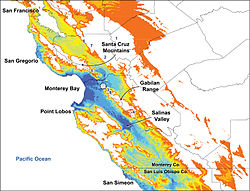| Illacme plenipes | |
|---|---|
 | |
| A female I. plenipes with 618 legs | |
| Scientific classification | |
| Kingdom: | Animalia |
| Phylum: | Arthropoda |
| Subphylum: | Myriapoda |
| Class: | Diplopoda |
| Order: | Siphonophorida |
| Family: | Siphonorhinidae |
| Genus: | Illacme |
| Species: | I. plenipes |
| Binomial name | |
| Illacme plenipes | |
 | |
| Predicted habitat suitability (maximum in blue) for I. plenipes based on climatic variables | |
Illacme plenipes is a siphonorhinid millipede found in the central region of the U.S. state of California. It has up to 750 legs. One of three known species in the genus Illacme , it was first seen in 1926, but was not rediscovered until 2005, almost 80 years after its discovery, by Paul Marek, then a Ph.D. student at East Carolina University. [1]